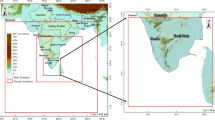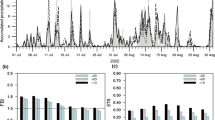Abstract
This study explores the controlling factors of the uncertainties and error growth at different spatial and temporal scales in forecasting the high-impact extremely heavy rainfall event that occurred in Zhengzhou, Henan Province China on 19–20 July 2021 with a record-breaking hourly rainfall exceeding 200 mm and a 24-h rainfall exceeding 600 mm. Results show that the strengths of the mid-level low-pressure system, the upper-level divergence, and the low-level jet determine both the amount of the extreme 24-h accumulated and hourly rainfall at 0800 UTC. The forecast uncertainties of the accumulated rainfall are insensitive to the magnitude and the spatial structure of the tiny, unobservable errors in the initial conditions of the ensemble forecasts generated with Global Ensemble Forecast System (GEFS) or sub-grid-scale perturbations, suggesting that the predictability of this event is intrinsically limited. The dominance of upscale rather than upamplitude error growth is demonstrated under the regime of k−5/3 power spectra by revealing the inability of large-scale errors to grow until the amplitude of small-scale errors has increased to an adequate amplitude, and an apparent transfer of the fastest growing scale from smaller to larger scales with a slower growth rate at larger scales. Moist convective activities play a critical role in enhancing the overall error growth rate with a larger error growth rate at smaller scales. In addition, initial perturbations with different structures have different error growth features at larger scales in different variables in a regime transitioning from the k−5/3 to k−3 power law. Error growth with conditional nonlinear optimal perturbation (CNOP) tends to be more upamplitude relative to the GEFS or sub-grid-scale perturbations possibly owing to the inherited error growth feature of CNOP, the inability of convective parameterization scheme to rebuild the k−5/3 power spectra at the mesoscales, and different error growth characteristics in the k−5/3 and k−3 regimes.
Similar content being viewed by others
References
Bei N, Zhang F. 2007. Impacts of initial condition errors on mesoscale predictability of heavy precipitation along the Mei-yu front of China. Q J R Meteorol Soc, 133: 83–99
Birgin E G, Martínez J M, Raydan M. 2001. Algorithm 813: SPG—Software for convex-constrained optimization. ACM Trans Math Softw, 27: 340–349
Bougeault P, Toth Z, Bishop C, Brown B, Burridge D, Chen D H, Ebert B, Fuentes M, Hamill T M, Mylne K, Nicolau J, Paccagnella T, Park Y Y, Parsons D, Raoult B, Schuster D, Dias P S, Swinbank R, Takeuchi Y, Tennant W, Wilson L, Worley S. 2010. The THORPEX interactive grand global ensemble. Bull Amer Meteorol Soc, 91: 1059–1072
Cressman G P. 1959. An operational objective analysis system. Mon Weather Rev, 87: 367–374
Durran D R, Gingrich M. 2014. Atmospheric predictability: Why butterflies are not of practical importance. J Atmos Sci, 71: 2476–2488
Durran D R, Weyn J A. 2016. Thunderstorms do not get butterflies. Bull Am Meteorol Soc, 97: 237–243
Ehrendorfer M, Errico R M, Raeder K D. 1999. Singular-vector perturbation growth in a primitive equation model with moist physics. J Atmos Sci, 56: 1627–1648
Grell G A, Dudhia J, Stauffer D R. 1995. A description of the fifth-generation Penn State/NCAR Mesoscale Model (MM5). NCAR Tech Note NCAR/TN-398+STR. 121
Hakim G J, Torn R D. 2008. Ensemble synoptic analysis. In: Bosart L F, Bluestein H B, eds. Synoptic-Dynamic Meteorology and Weather Analysis and Forecasting: A Tribute to Fred Sanders. Boston: American Meteorological Society
Hawblitzel D P, Zhang F, Meng Z, Davis C A. 2007. Probabilistic evaluation of the dynamics and predictability of the mesoscale convective vortex of 10–13 June 2003. Mon Weather Rev, 135: 1544–1563
Hong S Y, Noh Y, Dudhia J. 2006. A new vertical diffusion package with an explicit treatment of entrainment processes. Mon Weather Rev, 134: 2318–2341
Iacono M J, Delamere J S, Mlawer E J, Shephard M W, Clough S A, Collins W D. 2008. Radiative forcing by long-lived greenhouse gases: Calculations with the AER radiative transfer models. J Geophys Res, 113: D13103
Jiménez P A, Dudhia J, González-Rouco J F, Navarro J, Montávez J P, García-Bustamante E. 2012. A revised scheme for the WRF surface layer formulation. Mon Weather Rev, 140: 898–918
Judt F. 2018. Insights into atmospheric predictability through global convection-permitting model simulations. J Atmos Sci, 75: 1477–1497
Judt F. 2020. Atmospheric predictability of the tropics, middle latitudes, and polar regions explored through global storm-resolving simulations. J Atmos Sci, 77: 257–276
Liang Y, Qiao C, Dong J. 2020. Spatial-temporal distribution and impact analysis of the first rainstorm in Henan Province of the recent 34 years (in Chinese). Meteorol Environ Sci, 43: 26–32
Lorenz E N. 1963. Deterministic nonperiodic flow. J Atmos Sci, 20: 130–141
Lorenz E N. 1969. The predictability of a flow which possesses many scales of motion. Tellus, 21: 289–307
Lorenz E N. 1982. Atmospheric predictability experiments with a large numerical model. Tellus, 34: 505–513
Lorenz E N. 1996. Predictability—A problem partly solved. In: Proceedings of Seminar on Predictability. Reading, United Kingdom, ECMWF. 1–18
Lynch S L, Schumacher R S. 2014. Ensemble-based analysis of the May 2010 extreme rainfall in Tennessee and Kentucky. Mon Weather Rev, 142: 222–239
Melhauser C, Zhang F. 2012. Practical and intrinsic predictability of severe and convective weather at the mesoscales. J Atmos Sci, 69: 3350–3371
Mu M, Duan W. 2003. A new approach to studying ENSO predictability: Conditional nonlinear optimal perturbation. Chin Sci Bull, 48: 1045–1047
Mu M, Xu H, Duan W. 2007. A kind of initial errors related to “spring predictability barrier” for El Niño events in Zebiak-Cane model. Geophys Res Lett, 34: L03709
Nielsen E R, Schumacher R S. 2016. Using convection-allowing ensembles to understand the predictability of an extreme rainfall event. Mon Weather Rev, 144: 3651–3676
Ran L, Li S, Zhou Y, Yang S, Ma S, Zhou K, Shen D, Jiao B, Li N. 2021. Observational analysis of the dynamic, thermal, and water vapor characteristics of the “7·20” extreme rainstorm event in Henan Province (in Chinese). Chin J Atmos Sci 45: 1366–1383
Rotunno R, Snyder C. 2008. A generalization of Lorenz’s model for the predictability of flows with many scales of motion. J Atmos Sci, 65: 1063–1076
Selz T. 2019. Estimating the intrinsic limit of predictability using a stochastic convection scheme. J Atmos Sci, 76: 757–765
Selz T, Craig G C. 2015. Upscale error growth in a high-resolution simulation of a summertime weather event over Europe. Mon Weather Rev, 143: 813–827
Shi W, Li X, Zeng M, Zhang B, Wang H, Zhu K, Zhuge X. 2021. Multi-model comparison and high-resolution regional model forecast analysis for the “7·20” Zhengzhou severe heavy rain. Trans (in Chinese). Atmos Sci, 44: 688–702
Skamarock W C. 2004. Evaluating mesoscale NWP models using kinetic energy spectra. Mon Weather Rev, 132: 3019–3032
Skamarock W C, Klemp J B, Dudhia J, Gill D O, Liu Z, Berner J, Wang W, Powers J G, Duda M G, Barker D, Huang X Y. 2021. A Description of the Advanced Research WRF Model Version 4.3. NCAR Technical Note NCAR/TN-556+STR
Sun Y Q, Zhang F. 2016. Intrinsic versus practical limits of atmospheric predictability and the significance of the butterfly effect. J Atmos Sci, 73: 1419–1438
Sun Y Q, Zhang F. 2020. A new theoretical framework for understanding multiscale atmospheric predictability. J Atmos Sci, 77: 2297–2309
Sun Y Q, Rotunno R, Zhang F. 2017. Contribution of moist convection and internal gravity waves to building the atmospheric −5/3 kinetic energy spectra. J Atmos Sci, 74: 185–201
Sun Y, Xiao H, Yang H, Ding J, Fu D, Guo X, Feng L. 2021. Analysis of dynamic conditions and hydrometeor transport of Zhengzhou super heavy rainfall event on 20 July 2021 based on optical flow field of remote sensing data (in Chinese). Chin J Atmos Sci, 45: 1384–1399
Thompson G, Eidhammer T. 2014. A study of aerosol impacts on clouds and precipitation development in a large winter cyclone. J Atmos Sci, 71: 3636–3658
Weyn J A, Durran D R. 2017. The dependence of the predictability of mesoscale convective systems on the horizontal scale and amplitude of initial errors in idealized simulations. J Atmos Sci, 74: 2191–2210
Weyn J A, Durran D R. 2019. The scale dependence of initial-condition sensitivities in simulations of convective systems over the southeastern United States. Q J R Meteorol Soc, 145: 57–74
Wilks D S. 1995. Statistical Methods in the Atmospheric Sciences: An Introduction. San Diego, CA: Academic Press. 467
Wu N, Zhuang X, Min J, Meng Z. 2020. Practical and intrinsic predictability of a warm-sector torrential rainfall event in the south China monsoon region. J Geophys Res-Atmos, 125: e31313
Yu H, Meng Z. 2016. Key synoptic-scale features influencing the high-impact heavy rainfall in Beijing, China, on 21 July 2012. Tellus A-Dynamic Meteorol Oceanography, 68: 31045
Yu H, Meng Z. 2022. The impact of moist physics on the sensitive area identification for heavy rainfall associated weather systems. Adv Atmos Sci, 39: 684–696
Zhang C, Wang Y. 2017. Projected future changes of tropical cyclone activity over the western North and South Pacific in a 20-km-mesh regional climate model. J Clim, 30: 5923–5941
Zhang F, Bei N, Rotunno R, Snyder C, Epifanio C C. 2007. Mesoscale predictability of moist baroclinic waves: Convection-permitting experiments and multistage error growth dynamics. J Atmos Sci, 64: 3579–3594
Zhang F, Snyder C, Rotunno R. 2002. Mesoscale predictability of the “surprise” snowstorm of 24–25 January 2000. Mon Weather Rev, 130: 1617–1632
Zhang F, Sun Y Q, Magnusson L, Buizza R, Lin S J, Chen J H, Emanuel K. 2019. What is the predictability limit of midlatitude weather? J Atmos Sci, 76: 1077–1091
Zhang M, Meng Z. 2018. Impact of synoptic-scale factors on rainfall forecast in different stages of a persistent heavy rainfall event in south China. J Geophys Res-Atmos, 123: 3574–3593
Zhang X. 2021. Impacts of different perturbation methods on multiscale interactions between multisource perturbations for convection-permitting ensemble forecasting during SCMREX. Q J R Meteorol Soc, 147: 3899–3921
Zhang X, Yang H, Wang X, Shen L, Wang D, Li H. 2021. Analysis on characteristic and abnormality of atmospheric circulations of the July 2021 extreme precipitation in Henan (in Chinese). Trans Atmos Sci, 44: 672–687
Zhang Y, Zhang F, Stensrud D J, Meng Z. 2016. Intrinsic predictability of the 20 May 2013 tornadic thunderstorm event in Oklahoma at storm scales. Mon Weather Rev, 144: 1273–1298
Zhuang Y, Xing A. 2022. History must not repeat itself-urban geological safety assessment is essential. Nat Hazards, 111: 2141–2145
Zou X L, Vandenberghe F, Pondeca M, Kuo Y H. 1997. Introduction to adjoint techniques and the MM5 adjoint modeling system. NCAR Tech. Note NCAR/TN2435+STR. 110
Acknowledgements
The WRF ensemble forecasts were performed on the Stampede 2 supercomputer of the Texas Advanced Computing Center (TACC) through the Extreme Science and Engineering Discovery Environment (XSEDE) program supported by the NSF. The CNOP simulations were performed on the Tianhe Supercomputer at the National Supercomputing Center of Tianjin, China. This work was supported by the National Natural Science Foundation of China (Grant Nos. 42030604, 41875051), the National Science Foundation (Grant No. AGS-1712290), and China Postdoctoral Science Foundation (Grant No. 2021M702725). Dr. Murong Zhang is sponsored by the MEL Outstanding Postdoctoral Scholarship from Xiamen University. Dr. Huizhen Yu is also supported by the East China Regional Meteorological Science and Technology Collaborative Innovation Fund (Grant No. QYHZ201801) and the project from the Qingdao Meteorological Bureau (Grant No. 2021qdqxz01).
Author information
Authors and Affiliations
Corresponding author
Supplement Materials
Rights and permissions
About this article
Cite this article
Zhang, Y., Yu, H., Zhang, M. et al. Uncertainties and error growth in forecasting the record-breaking rainfall in Zhengzhou, Henan on 19–20 July 2021. Sci. China Earth Sci. 65, 1903–1920 (2022). https://doi.org/10.1007/s11430-022-9991-4
Received:
Revised:
Accepted:
Published:
Issue Date:
DOI: https://doi.org/10.1007/s11430-022-9991-4




